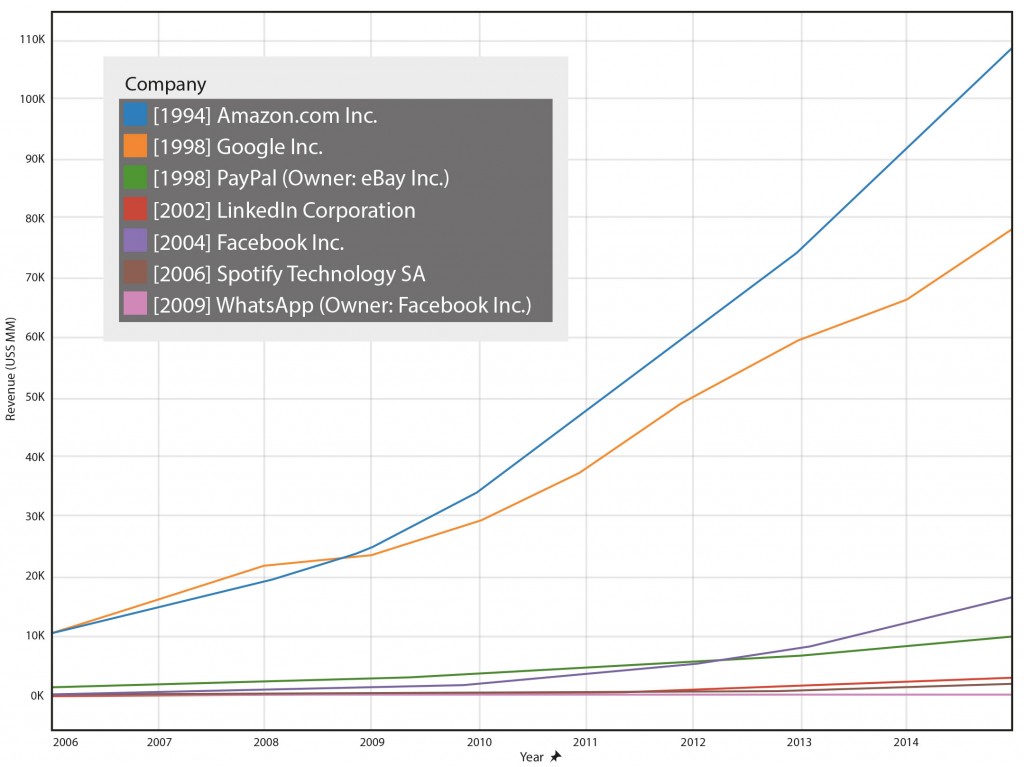By Josemaria Siota and Luiz Zorzella
How did LinkedIn achieved a 35% revenue growth in 20151, after suffering media earthquakes in the previous months? Some of the principles they followed: maximise the learning speed, minimise the testing cost, combine analytical thinking with creativity, and a deep customer-centricity, will be discussed in this article.
Top tech giants have tackled risky media shaking experience over the last few months. Ranging from the criticisms directed at PayPal over the bitcoin scam2, the protests against Amazon over the working conditions in their UK distribution centres3 to the polemics between the best-selling music artist Taylor Swift and the way Spotify compensates the music industry4. Google has suffered the “Project Goliath” lobbying campaign denouncing their third-party information policies in US5 and there have been complaints raised against Facebook and LinkedIn about content blocking in Russia and China6 7. Finally, there has been persistent media pressure against Zuckerberg about the workings of its WhatsApp acquisition8. In conclusion, these companies were immersed in volatile business atmosphere over many many months.
In contrast, although those top tech titans have different foundations dates between 1994 and 2009; six of seven have achieved billion-dollar in revenue milestone, and financial analysts foretell a 28% revenue growth on average during 2015 for the selected group.
This percentage follows their stupendous rise in revenue during the last ten years, as we see in the following chart, which includes the historical and predicted revenues in US$ millions from 2006 to 2015 for each organisation.
In summary, the selected tech titans group is going to achieve approximately 28% revenue growth in an extremely fast changing environment. But how is the group achieving those growth rates?
In the foreword of the McGraw-Hill book “Revenue Growth: Four Proven Strategies”9, the Harvard Business School professor Thales Teixeira states:
“Long gone are the days of setting a long-term strategy and following it closely. Today’s business environment requires that managers adapt and change their business models on an on-going basis. Fast-paced dynamics demand a constant need for firms to make changes to their strategies in order to achieve sustained revenue growth. But how can constant drastic changes in strategies be compatible with sustained growth?”
In other words, what could tech startups and growth companies learn from those billion-dollar giants in order to not only tackle their unpredictable business circumstances, but also grow at the same time?
To answer this question, the book authors propose a new actionable framework to sustain growth in tech companies in changing environments with scarce resources. The authors analysed 77 companies from 21 countries, reached 780 executives from 32 nationalities, from high growth companies such as Amazon, Facebook, Google, LinkedIn, PayPal, Spotify, WhatsApp, many others.
The proposed methodology is based on the three following principles applicable to four core areas: market, products, pricing and distribution channels.
Source: own creation with Tableau Software.
Note: the 28% revenue growth is the average of revenue growths of the selected seven organisations. Those percentages and the revenue chart are own calculations done with data and predictions coming from Bloomberg Businessweek, Orbis Database, Business Insider, TechCrunch, Money, Statista and websites of the selected companies. Additionally, for simplification, we have considered the analysis of WhatsApp and PayPal in the chart, as different companies during the period 2006-2015. However, Facebook acquired WhatsApp in 2014 and PayPal separated from eBay in 2015.
Maximise your learning speed and minimise your testing cost. On average, tech startups die after ~20 months10 from its last funding round because entrepreneurs don’t usually have time and money enough to validate their business models, improve their assumptions and learn what works. Therefore they should prioritise learning and costs metrics: what the authors called a lean growth approach.
As Naman Agarwall, business development manager at Amazon India says in one of the book’s interviews, “we should verify our hypothesis faster and improve our cyclical process of learning, hypothesis, test, and re- learning”11.
“The key would be to discover the best way to do a fast validation”. For example, “it is better to start with something smaller, test it and then scale it”, states Katia Yakovleva, account director at Spotify Germany.
Use not only analytical thinking, but also creativity. No financial analyst predicted before the iPhone release that today would be “1.7 billion smartphones, increasing by a 20% growth rate” says Anurag Garodia, sales team lead at Google.
Therefore, executives should not drive their companies with just predicting the future with analytical thinking, but they should also be creating opportunities by combining analytical thinking with creativity.
Otherwise, just analysing past data, without testing new solutions, executives may “lose those growth opportunities”, states Patty Cox, LinkedIn former global brand lead.
Never assume you are right, always ask customers. Empirically 3 of every 4 startups fail12, 42% of those10 failures can be ascribed to the gap between what entrepreneurs assume the market wants and what the market actually wants.
Thus, as Elies Campo, WhatsApp former business development executive says, executives really need to validate their business assumptions “out of the building and talking to customers”; in order to “test if you have a product you want to sell or a product customers want to buy, without waiting for the end of the product development”, affirms Raimundo Sala, head of sales at PayPal Iberia.
Those validations could be done in many ways. For instance, “I would suggest listening to your customers, keep learning through conversations with customers that are talking to you through the data”, affirms Dinesh Dheenathayalan, Asia-Pacific sales operations at Facebook Singapore.
In conclusion, tech startups and growth companies may learn from these big giants and growth leaders that in order to survive the current volatile business atmosphere, they should focus on learning metrics to check their business assumptions with customers, while combining the analytical-creative thinking.
For futher information on successful principles for growth in tech companies, visit www.revenuegrowth.info
About the Authors
 Josemaria Siota is the Director at Simastec Consulting and collaborates in research projects with IESE Business School. He is a Deloitte former consultant.
Josemaria Siota is the Director at Simastec Consulting and collaborates in research projects with IESE Business School. He is a Deloitte former consultant.
 Luiz Zorzella is the Director at Amquant. He is a McKinsey former consultant and JP Morgan former investment banker.
Luiz Zorzella is the Director at Amquant. He is a McKinsey former consultant and JP Morgan former investment banker.
Both authors published the McGraw-Hill book “Revenue Growth: Four Proven Strategies”, after reaching 780 executives from Amazon, Facebook, Google, LinkedIn, PayPal, Spotify and WhatsApp.
References
1. LinkedIn Announces First Quarter 2015 Results. https://press.
linkedin.com/site-resources/news-releases/2015/linkedin-announces-first-quarter-2015-results. Accessed on: 2015, July 30th.
2. Jones, R. Paypal Washes Its Hands Of Bitcoin Scam. http://www.theguardian.com/money/2014/mar/01/paypal-bitcoin-scam-ebay. Accessed on: 2015, July 30th.
3. Farrell, S. Amazon To Hire 1,000 UK Distribution Staff. http://www.theguardian.com/technology/2014/oct/13/amazon-hires-1000-uk-distribution-staff.Accessed on: 2015, July 30th.
4. Crook, J. Taylor Swift Explains Why She Knew Spotify Was Trouble. http://techcrunch.com/2014/11/07/taylor-swift-explains-why-she-knew-spotify-was-trouble/. Accessed on: 2015, July 30th.
5. Wingfield, N. Google’s Detractors Take Their Fight To The States. http://www.nytimes.com/2014/12/17/technology/googles-critics-enlist-state-attorneys-general-in-their-fight.html. Accessed on: 2015, July 30th.
6. Presse, A.F. Russian Facebook Blocks Event Page For Opposition Rally. http://www.theguardian.com/technology/2014/dec/21/russian-facebook-blocks-event-page-opposition-alexei-navalny. Accessed on: 2015, July 30th.
7. Branigan, T. Linkedin Under Fire For Censoring Tiananmen Square Posts. http://www.theguardian.com/technology/2014/jun/04/linkedin-tiananmen-posts-china-censorship. Accessed on: 2015, July 30th.
8. Perez, S. WhatsApp Experiences Second Major Outage Following Facebook Acquisition.http://techcrunch.com/2014/04/02/whatsapp-experiences-second-major-outage-following-facebook-acquisition/. Accessed on: 2015, July 30th.
9. Siota, J. and Zorzella, L., Revenue Growth: Four Proven Strategies. 2014: McGraw-Hill.
10. The R.I.P. Report – Startup Death Trends. 2014, CB Insights.
11. Note: all quotes come from interviews with Growth Leaders included in the cited book. Opinions expressed by all interviewees are solely their own and do not express the views or opinions of their respective employers.
12. Gage, D. The Venture Capital Secret: 3 Out of 4 Start-Ups Fail. http://www.wsj.com/news/articles/SB10000872396390443720204578004980476429190. Accessed on: 2015, July 30th.



































